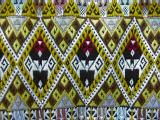 THAILAND--Part Eight
THAILAND--Part Eight
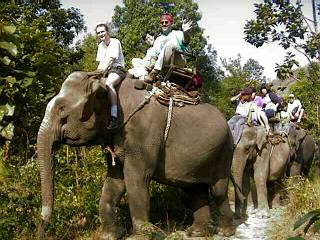 A
couple of days later, I headed out on a great adventure to visit hill
tribe villages in the highlands outside of Chiang Mai. I'd never ridden
on an elephant before, and for part of the journey that was the preferred
method of transportation. Elephants are highly respected in Thailand (remember
the symbol for the Asia Games?), and are even protected by law. You could
say they're thought of in Thailand the way cows are in India. The Thai
army even used to have a special Elephant Corps!
A
couple of days later, I headed out on a great adventure to visit hill
tribe villages in the highlands outside of Chiang Mai. I'd never ridden
on an elephant before, and for part of the journey that was the preferred
method of transportation. Elephants are highly respected in Thailand (remember
the symbol for the Asia Games?), and are even protected by law. You could
say they're thought of in Thailand the way cows are in India. The Thai
army even used to have a special Elephant Corps!
| The term "hill tribes" refers to the people who live in the upland valleys and hill sides of northern Thailand. Many also live in the mountains of Myanmar, Laos, Cambodia, and Vietnam. Read an introduction to the hill tribes of Thailand. |
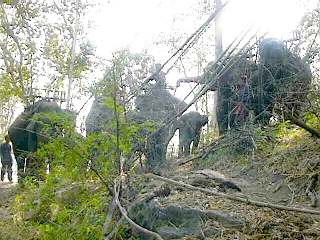
Along the road, we came across this group of elephants being used by loggers
to clear this section of the forest. Not many wild elephants are left
in Thailand; most have been captured and are used in this way. (There
are many endangered species of animals in Thailand, ranging from tigers
to a wild ox called the gaur; other species are already extinct,
like single- and double-horned rhinos and the Schomburgk deer, which was
hunted out of existence for its prized horns.) Logging is a huge industry
in Thailand, with the lumber used mostly for furniture and housing. Much
of the world's teak wood used to come from Thailand -- but, like much
of the country's forest resources, it has been almost completely used
up. In 1988, a survey was done showing that the country's forested areas,
which used to cover almost all of Thailand, now only covered 28%! Despite
a ban on much logging, and a government reforestation program, the forests
continue to shrink, much to everyone's disadvantage.
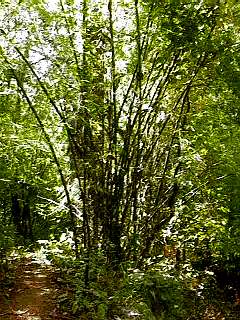
One answer may lie in this resource. Recognize it? This
is bamboo. What's great about bamboo is that it's an easily renewable
resource: indeed, to keep it growing and healthy, it NEEDS to be cut back.
Bamboo can be used to make many things, too, from piping to transport
water to house frames, floors and walls to furniture and much, much more.
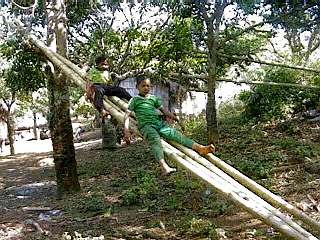
As we got near the first village belonging to the Lahu
tribe, we saw this example of an innovative use of bamboo. Looks like
fun to me!
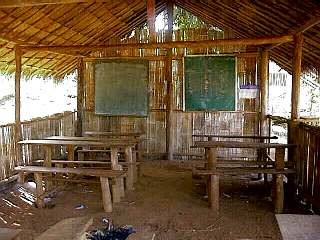
This first village was quite small, with only about sixty-five
people. While a few children were around, the adults must have been out
in the fields. It was right around lunch time, so the kids must have been
on a break from school. This school house is awfully small, too, serving
only this village, so I'm not sure they have a set schedule for classes;
it's likely the teacher was out in the fields working.
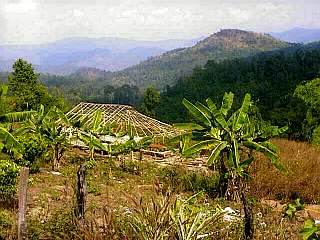
The next village we came to was a Karen village. My guide,
Rak, was scoping it out as a possible place for a group to stay in. The
village heard he was coming, and decided to build a new house for potential
guests to stay in. They put up this structure in two hours!
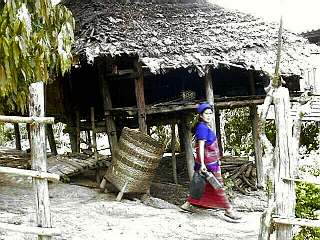
This Karen house is built in the traditional
style. It is made entirely of wood, with no nails -- the pieces are designed
to fit together perfectly. It's a moveable house, so if the villagers
decide to move they can take the house apart and move it with them. It's
also on stilts, to protect it from gushing water during the monsoon season.
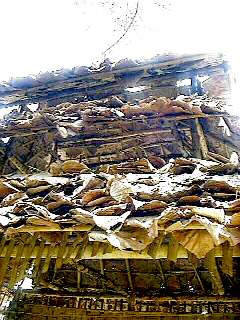
This is a close-up of the roof of the house, which is
made from overlapping leaves found in the forest that are bound to a wood
frame. It works!
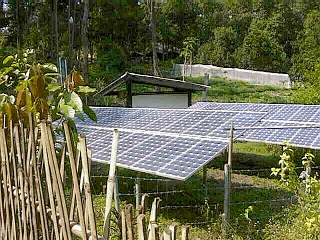
I was amazed to find these solar panels on the outskirts
of the village. Talk about the new mixing with the old...!
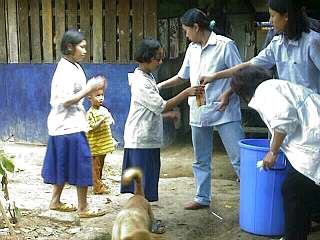 Rich
as the hill tribe people's cultures are, they face problems, many of which
come from their having to relocate in order to accommodate the government's
program of managing public lands. Many have nowhere to go, and have no
way to survive outside the forest. If the land they come to is not productive,
they suffer from sometimes-severe poverty. (This can be very hard to understand
for a hill tribe person, who DO think of the land as "public", so that
having a government from far away tell them to move makes little sense.)
The king himself, and his family, often help out. They often visit villages
like this one, and start up special projects to address problems they
see. This milk program for school children was started after the king's
daughter came for a visit.
Rich
as the hill tribe people's cultures are, they face problems, many of which
come from their having to relocate in order to accommodate the government's
program of managing public lands. Many have nowhere to go, and have no
way to survive outside the forest. If the land they come to is not productive,
they suffer from sometimes-severe poverty. (This can be very hard to understand
for a hill tribe person, who DO think of the land as "public", so that
having a government from far away tell them to move makes little sense.)
The king himself, and his family, often help out. They often visit villages
like this one, and start up special projects to address problems they
see. This milk program for school children was started after the king's
daughter came for a visit.
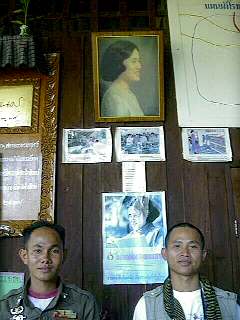
Here, a picture of the king's daughter hangs above my
other guide, Kaew, and the principal of the local school. You can see
in the next photo that this school is much nicer than the one in the Lahu
village; partly that's because of the influence of the king's daughter,
but mostly because this is a much larger village of about four hundred
people. The principal is a member of the army, which runs many of the
hill tribe schools. That is because the area where the hill tribes live
is often considered unsafe -- here, many of the Karen have come from Myanmar,
where they are fighting against the government to become an independent
state, and the fighting sometimes filters over the border into Thailand.
Rak told me the army HAS to teach here because teachers from the city
consider it too unsafe a place to live. So, per the princess's orders,
army members are trained to teach in the country's education colleges,
then sent to this area to work with hill tribe children.
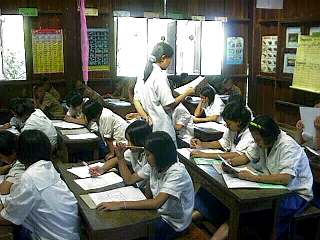
This K-6 school has six teachers and 142 students drawn
from two local villages with a total population of about 600. (That's
a LOT of younger kids for that population!) With the classrooms run by
the army, I wondered just how much the students learn about their own
culture. The answer is: none. The schools serve to teach them about Thai
language and culture, so that they will be ready to enter into "mainstream"
Thai society, while education about their own culture is left for the
home. I can see why the government feels it's important for the hill tribe
people to learn about mainstream Thailand in order to "reduce cultural
misunderstandings", as the government says, but I also think it's equally
important for the Thai to learn about hill tribe culture in order to appreciate
and maintain those cultures. It's a difficult problem, and one that sounds
very familiar to me, teaching in a multicultural place like San Francisco!
(One program the king supports is identifying talented youth in the hill
tribe communities, giving them scholarships to go to college, then meeting
with them personally as a group at graduation to ask them how they're
going to take what they've learned to help out their own villages when
they return, which they're required to do to get the scholarships in the
first place. I think that's a great program, and another reason to admire
the king.)
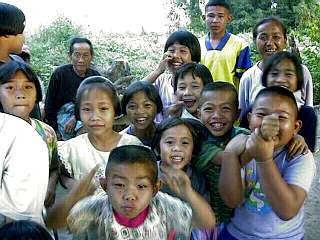
Just some Karen kids saying hi!
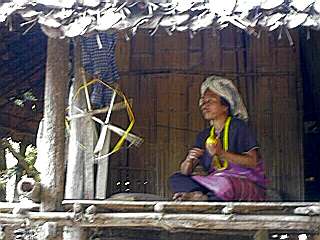
Out in the village, we saw this Karen woman spinning thread
that will be used to weave some traditional fabric. Weaving is one of
the most important of Thailand's traditional crafts, and the products
are considered some of the most beautiful made anywhere in the world.
Among the hill tribes, each produces its own type, with characteristic
colors, patterns and textures. It is easy to identify what tribe someone
comes from if they're wearing their traditional clothing.
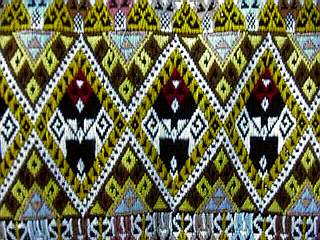
This is one of the more beautiful pieces of weaving I
saw in Thailand. (While it wasn't made by one of the hill tribes, but
rather by a Tai weaver, you can bet that many of the hill tribe pieces
are equally stunning.) What I especially like about this piece is that
it tells a story. The pattern is called the Black Swan (look closely and
you can see the swans), and it's related to one of the Jataka Tales that
describe the many lives of the Buddha before the one where he attained
enlightenment as Siddhartha Gautama. Thailand has wonderful stories, and
it's amazing to me that they're even told through the clothes people wear!
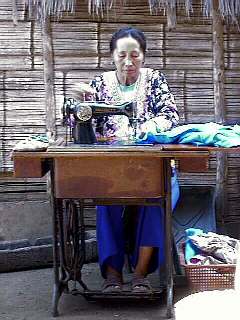
In the next village we came to, which belongs to the Hmong
people, we saw another example of the talents of the hill tribe people
in making beautiful clothing. You may be impressed by how many villages
we could visit in a single day. In fact, the villages are very close to
one another: while it took us three hours to get to the first one and
then another hour to get to the second, the next ones were all right next
door to each other. (Which is not to say it's easy walking; it's very
hilly, which is one reason, according to my guide, you can tell a hill
tribe person in the city even if they're dressed in city clothes -- they
WALK different -- on the balls of their feet, which is how you walk when
you're in the hills all the time!) You might think having villages so
close together would cause conflicts, given that each belongs to a different
tribe, but Rak told me that in his twelve years of visiting the area he
hasn't seen or heard of a single fight between them. To the contrary,
he's seen many instances of them working together on projects of common
interest, like building a water-delivery system.
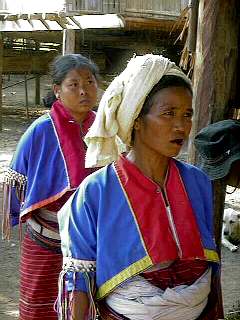
In the next village we visited, we met these Padong women
dressed in their traditional clothing. It's worth mentioning that the
queen of Thailand has played a major role in supporting traditional Thai
crafts, such as weaving of these clothes. Part of her activity stems from
her commitment to preserving Thailand's natural and cultural heritage,
including that of the hill tribes. It also has to do with the king's support
for the country's efforts to change from an economy that exports its raw
natural resources (which generates little profit) to one that manufactures
products for export, employing people like these women and bringing more
money into their pockets. Manufactured products now make up 70% of Thailand's
exports (in 1960, that figure was only 3%), and textiles are the number
one export, above even foods!
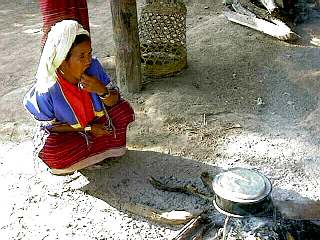
One of the Padong women was cooking dinner over a wood
fire. This gives you an idea of the simple methods used by many hill tribes
to deal with the needs of everyday life.
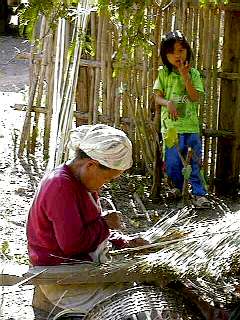
In the next village, another one belonging to the Karen,
a woman was weaving again -- only this time, she was weaving together
grass for a roof to be used on a new house the villagers were building.
Thai people also weave rattan (a kind of wicker) into furniture, and palm
leaves into fans and mats. They often use fibers of different natural
colors to weave together into beautiful patterns in boxes and handbags,
too.
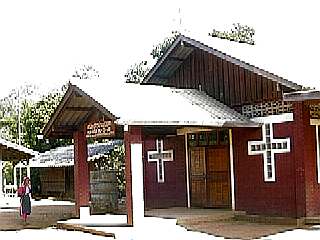
The last village we visited was Lisu. Like most Karen,
many Lisu are Christians, reflecting the influence of the many missionaries
who have traveled through this region of the world. While more hill tribe
people are Buddhist, they are virtually all animists, mixing their beliefs
in spirits with those of the Christianity or Buddhism they have also adopted.

And, on the way out of the forest, we saw this tree that
gives further evidence of that "religious syncretism" (mixing). This is
a Buddhist tradition of swathing a tree that has been overused (in this
case, tapped for its gluey sap) to protect it from the spirits. It also
serves the very practical function of stopping people from using it even
more, thereby allowing the tree to grow back to a healthier state.
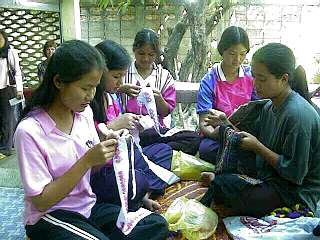
I returned to Chiang Mai with a fascination about the
hill tribes, and looked for what I could find out about them in the city
itself. This led me to a program at the New Life Center. One of the most
tragic consequences of the poverty found in many hill tribe villages is
that young girls in the villages are tricked or sold into slavery or prostitution.
(In some cases, parents are told that their child has been chosen for
a job in the city, and are given an "advance" on her salary, when in fact
she is then forced to work in a brothel; in other cases, the girls' parents
are opium-addicted and easy prey for someone willing to give them some
money to support their addiction; and, in yet others, the girl has no
parents and lives where tribal leaders make money by selling girls.) The
New Life Center gives shelter to girls who are at-risk or already in such
abusive situations, provides them with tutoring (few have had any formal
education), enrolls them in night education classes, and teaches them
to be self-sufficient by training them to produce tribal handicrafts that
they can then sell. (There are many NGO's in Thailand that do work in
all areas of public service; write
me if you want to know more.)
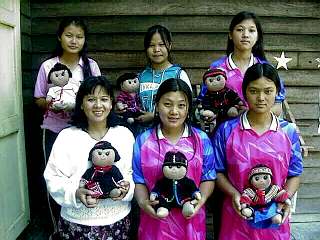
One hundred and forty girls, aged 14 to 24, live at the
center. They come from many different tribes. In this photo, clockwise
from top left, Saikeaw is Karen; Mola is Lahu; Buu Ya is Akha; Buu Mia
is Akha; and Mii Nong is Akha. (Other residents are Lisu, Hmong and Mien
as well.) Each is holding a doll she has made dressed in the traditional
clothing of her tribe. (When asked what they wanted you to know about
the center, they said that "there are lots of tribes here, and we learn
a lot from each other about our weaving styles, dances and so on.") At
the bottom left is Judy, who is the assistant director of the center and
Lahu herself. The center also looks to train young women with leadership
potential to go back to work in their villages, and Judy is a role model.
She did have an opportunity to go to school when she was young, and now
works at Chiang Mai University as well as at the center.
|
The New Life Center does many wonderful things for the young women it works with. But I wondered if it was really the BEST thing that could be done -- for example, if something could be done in the villages to educate and warn parents about the real intentions of those offering "jobs" to their daughters, AND to provide support for economic development of the villages, that might help solve the problem before it arose.
|
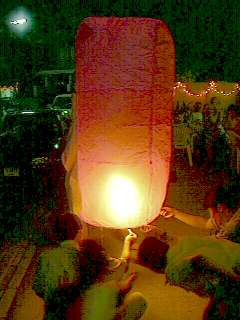
HAPPY NEW YEAR! Because Thailand has people of so many
backgrounds, they celebrating many holidays and festivals, some ancient
and animist, some Buddhist, some Chinese, and others related to important
Thai historical events. Even though January 1 is not the traditional,
ancient Thai new year, it's now celebrated throughout the country. (Traditional
Thai New Year comes in April, and is called Songkran-- it's now the year
2502 by that calendar system, which started in the year of the Buddha's
death.) On New Year's Eve in Chiang Mai, one of the traditions is to send
hot air balloons into the sky. Some of them are huge. The people at my
guest house only had a couple of medium-sized ones, though. They lit the
fuel lamp to heat up the air inside the paper balloon, then waited a while
for the air inside to get hot enough...
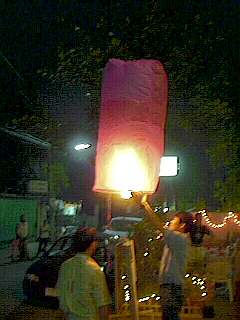
...and launched it up into the cool night air. By the
time midnight hit, there were literally hundreds of balloons up in the
air. Each was high enough that it looked like a small point of light,
giving the appearance that there were tons of planets showing up in the
heavens that night!
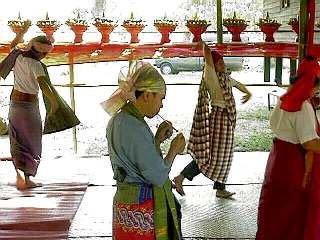
On New Year's Day, I accepted an invitation to come to
a performance of tribal dance and music at Chiang Mai University. It's
very hard to describe what it was like, but this picture might help. The
dancers were all very ecstatic while they danced, talking and laughing
with each other, and smoking from their pipes...
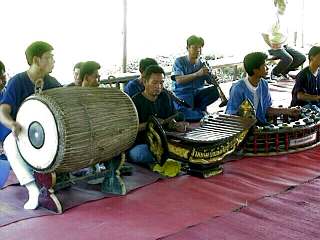
...while an almost eerie music, pulsing
with rhythm and swirling around the nasal sound of the oboe-like instrument
in the back row, played throughout. The instruments used by Thai orchestras,
whether Tai or tribal, originally come from China -- another example of
the influence of that great land to the north.
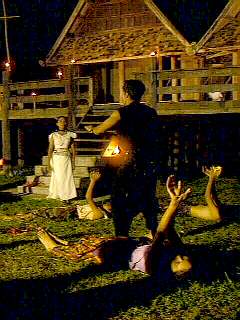
At night, after the music and dance were over, I got to
see an amazing play put on by a famous dramatist who brought his play
from Bangkok to Chiang Mai for this performance. The play was about Asoka,
the first Buddhist king of India. His intention in writing this play was
to re-introduce Thai audiences to this great figure, a man who in his
early days was the leader of a ferocious and vicious army that killed
thousands -- then, one day, looked down at the dead on the battlefield
and realized the wrongs he had done. He devoted the rest of his life to
spreading the peaceful word of Buddhism. (And, yet another example of
the influence of India, that great land to the west, on Thai culture.)
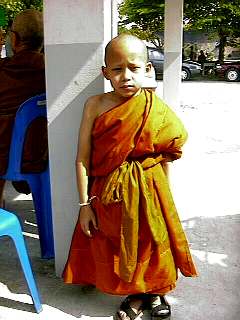
My last days in northern Thailand were sad ones, as the
husband of one of the friends I'd met while in Chiang Mai passed away
suddenly. I was asked to come to the funeral, where I met again some of
his family, including his cousin's son dressed here in his monk's robes.
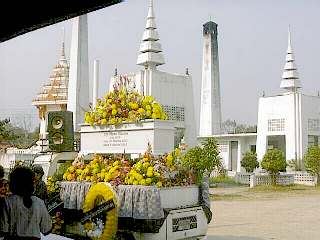
In Buddhist practice, the deceased
is cremated before burial in a crematorium such as this. A sad ending,
but in the Buddhist view, all things must pass, and my friend's husband
will return again in the endless cycle on his quest to reach nibbana.
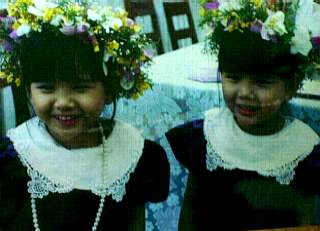 I
asked Judy if she thought a program
like this, which as part of its approach teaches "Christian values"
to the residents and offers strong incentives to convert to Christianity,
doesn't undermine their sense of tribal identity. She felt that
both programs needed to be done hand-in-hand: i.e., that the problem
needs to be addressed at its source, but also that these girls need
help NOW. And, the training in tribal handicrafts and in their native
languages helped them maintain pride in their tribal identity. Still,
she had to laugh a little when I pointed out that she has a Thai
husband and her two young daughters speak no Lahu. Certainly, it's
a thorny problem with no clear answer.
I
asked Judy if she thought a program
like this, which as part of its approach teaches "Christian values"
to the residents and offers strong incentives to convert to Christianity,
doesn't undermine their sense of tribal identity. She felt that
both programs needed to be done hand-in-hand: i.e., that the problem
needs to be addressed at its source, but also that these girls need
help NOW. And, the training in tribal handicrafts and in their native
languages helped them maintain pride in their tribal identity. Still,
she had to laugh a little when I pointed out that she has a Thai
husband and her two young daughters speak no Lahu. Certainly, it's
a thorny problem with no clear answer.